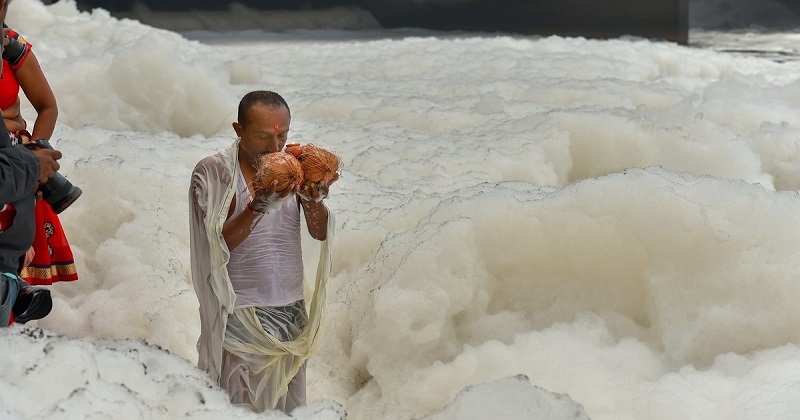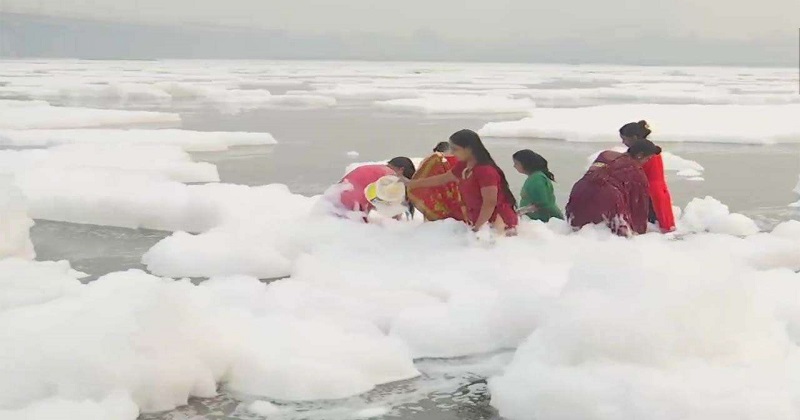
On Monday, a layer of toxic foam was seen floating over parts of the Yamuna river near Kalindi Kunj, while Chhath devotees stood in the water soaking up the foam.
Why does the Yamuna froth?
Polluted rivers produce froth. According to experts, the release of untreated or poorly treated effluents, such as sewage from parts of the city which are not connected to the sewerage system and industrial waste, could cause frothing. According to Sushmita Sengupta, Senior Programme Manager of the Water Programme at CSE, phosphates in the river form the froth. The sewage is not treated, so detergents and phosphates from industrial laundry and household detergents find their way into the river, Sengupta said. He also mentioned that the river is in a lean phase at this time of year and the water flow is reduced. Thus, pollutants aren’t diluted. As a result of turbulence near Okhla, phosphates produce foam, according to a DJB official.
The now-disbanded Yamuna Monitoring Committee had asked the Delhi Pollution Control Committee (DPCC) and the Central Pollution Control Board (CPCB) to inspect and submit reports about foam formation in July 2020. According to a CPCB report submitted in August last year, foam formation occurs downstream of the ITO and Okhla barrages. Upon discharge from the Okhla barrage, the water causes surfactants and foaming agents present in the wastewater or in the sludge on the river bed to be agitated, resulting in foam.

Who is responsible for the clean-up?
It has been suggested that the cause of the frothing may not be the Delhi Jal Board itself, based on the location of the phenomenon. An official at the Delhi Development and Regulatory Board said frothing is only spotted near Kalindi Kunj, downstream of the Okhla barrage, not throughout the river, since drains begin emptying into the river shortly after the Wazirabad barrage. ‘There is a drain that comes from UP and empties into the river near Kalindi Kunj. The drain contains untreated sewage that pollutes the river,’ the official said.
At a briefing on Monday, DJB vice-chairman Raghav Chadha said the Okhla barrage is maintained by the UP Irrigation Department, and that the foam floating in the river near the barrage is a result of detergents and toxic waste. Phosphates are present in excessive amounts in the river not only near the Okhla barrage. Sengupta said the foam at that point must be a result of the pollutants that are high at that point near Okhla. It says that phosphates and surfactants were not detected upstream of Wazirabad, but were found between ITO and downstream of the Okhla barrage in the CPCB report last year.
As per the DPCC report also submitted to the committee last year, Khajoori Paltoon, downstream of the Najafgarh drain, had the highest concentration of phosphate (13.42 mg/litre) and surfactants. There was a 12.26 mg/litre concentration at Okhla barrage and a 11 mg/litre concentration at Nizamuddin Bridge.
Read more: Islamist groom of Shamima Begum refuses to condemn beheadings, sex slavery: Report
How has it been handled?
A ban was imposed by the DPCC in June on the sale, storage, and transportation of soaps and detergents that did not meet the quality standards set by the Bureau of Indian Standards (BIS). This ban was recommended by the Yamuna Monitoring Committee, which has since disbanded. Despite BIS standards for detergents being improved, it is unclear whether these standards will actually be enforced, states the fifth report by the NGT-appointed Yamuna Monitoring Committee from December last year.
According to the report, the role of regulatory bodies such as CPCB, DPCC, and PCBs is limited to implementing discharge/effluent standards. The DJB is collecting samples from the river near the Okhla barrage to determine its phosphate content. Despite taking samples when necessary, the DJB does not monitor the levels daily, he explained. As part of his briefing, Chadha mentioned the DJB’s Interceptor Sewer Project (to treat sewage flowing into rivers through drains) as well as efforts to connect colonies in Delhi to the sewerage system.

Post Your Comments